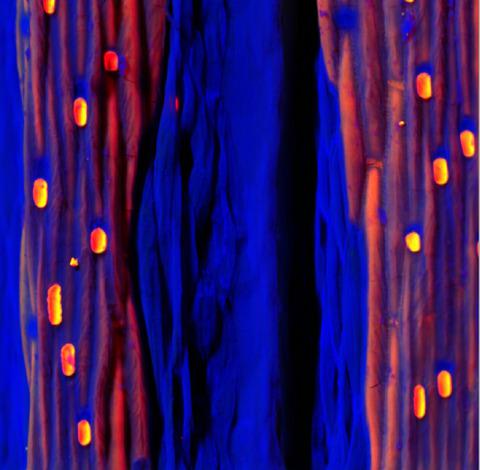当前位置:
X-MOL 学术
›
Funct. Ecol.
›
论文详情
Our official English website, www.x-mol.net, welcomes your feedback! (Note: you will need to create a separate account there.)
Leaf silicification provides herbivore defence regardless of the extensive impacts of water stress
Functional Ecology ( IF 5.2 ) Pub Date : 2021-03-24 , DOI: 10.1111/1365-2435.13794 Rebecca K. Vandegeer 1 , Ximena Cibils‐Stewart 1, 2 , Richard Wuhrer 3 , Susan E. Hartley 4 , David T. Tissue 1 , Scott N. Johnson 1
中文翻译:

无论水分胁迫的广泛影响如何,叶片硅化都能为食草动物提供防御
更新日期:2021-03-24
Functional Ecology ( IF 5.2 ) Pub Date : 2021-03-24 , DOI: 10.1111/1365-2435.13794 Rebecca K. Vandegeer 1 , Ximena Cibils‐Stewart 1, 2 , Richard Wuhrer 3 , Susan E. Hartley 4 , David T. Tissue 1 , Scott N. Johnson 1
Affiliation

|
- Altered precipitation patterns due to climate change are likely to impose water-deficit stress in plants resulting in changes to specific leaf mass, leaf water content and chemical defences that may impact herbivorous arthropods. Grasses, in particular, accumulate large concentrations of silicon (Si) which provides physical defence against herbivores. Although Si uptake by plants may be affected by water availability, very few studies have investigated the combined effect of water-deficit stress and Si on insect herbivore performance.
- We grew tall fescue Festuca arundinacea Schreb. hydroponically, with and without Si, and half of the plants were treated with 20% polyethylene glycol (PEG) to impose osmotic stress. In all, 11 leaf traits (physiological, chemical and structural) were measured, silicified phytoliths on the leaf surface were visualised using scanning electron microscopy (SEM) in conjunction with X-ray mapping, and plants were exposed to a chewing insect herbivore [Helicoverpa armigera Hübner (Lepidoptera: Noctuidae)].
- Although osmotic stress was associated with changes to leaf physiological and chemical traits, including increased specific leaf mass, decreased leaf relative water content and increased leaf nitrogen (N), there was no significant effect on H. armigera relative growth rate (RGR). However, Si reduced RGR of H. armigera by 80%–98% while generating few changes to physiological and chemical leaf traits. Instead, the decline in RGR with Si was associated with changes to leaf structural traits, in particular, a greater density of silicified phytoliths on the leaf surface.
- Comparison of effect sizes indicated that leaf traits were primarily affected by osmotic stress but not Si, and that herbivore RGR was strongly negatively affected by Si but not osmotic stress. There was no interactive effect between the osmotic stress and Si treatments on H. armigera RGR or plant traits except for leaf nitrogen and phenolic concentrations. This study provides further support that Si may prove to be beneficial to plants against chewing insect pests and remains robust regardless of water-deficit stress conditions.
中文翻译:

无论水分胁迫的广泛影响如何,叶片硅化都能为食草动物提供防御
- 由于气候变化而改变的降水模式可能会对植物造成缺水压力,导致特定叶质量、叶含水量和化学防御发生变化,这可能会影响食草节肢动物。尤其是草,会积累大量的硅 (Si),为食草动物提供物理防御。尽管植物对硅的吸收可能受水的可用性影响,但很少有研究调查缺水胁迫和硅对昆虫食草动物性能的综合影响。
- 我们种植了高大的羊茅Festuca arundinacea Schreb。水培,有和没有硅,一半的植物用 20% 聚乙二醇 (PEG) 处理以施加渗透胁迫。总共测量了 11 个叶子性状(生理、化学和结构),使用扫描电子显微镜 (SEM) 结合 X 射线绘图观察了叶子表面的硅化植硅体,并将植物暴露于咀嚼昆虫食草动物 [ Helicoverpa armigera Hübner(鳞翅目:夜蛾科)]。
- 虽然渗透胁迫与叶片生理和化学性状的变化有关,包括比叶质量增加、叶片相对含水量降低和叶片氮 (N) 增加,但对棉铃虫相对生长率 (RGR)没有显着影响。然而,Si 使棉铃虫的RGR 降低了 80%–98%,同时对叶片生理和化学性状几乎没有影响。相反,硅的 RGR 下降与叶片结构性状的变化有关,特别是叶片表面硅化植硅体的密度更大。
- 效应大小的比较表明,叶片性状主要受渗透胁迫而非 Si 影响,而食草动物 RGR 受 Si 而非渗透胁迫强烈负面影响。除叶氮和酚类浓度外,渗透胁迫和Si处理对棉铃虫RGR或植物性状没有交互作用。这项研究提供了进一步的支持,即 Si 可能被证明有利于植物对抗咀嚼昆虫害虫,并且无论缺水胁迫条件如何,都能保持健壮。


























 京公网安备 11010802027423号
京公网安备 11010802027423号